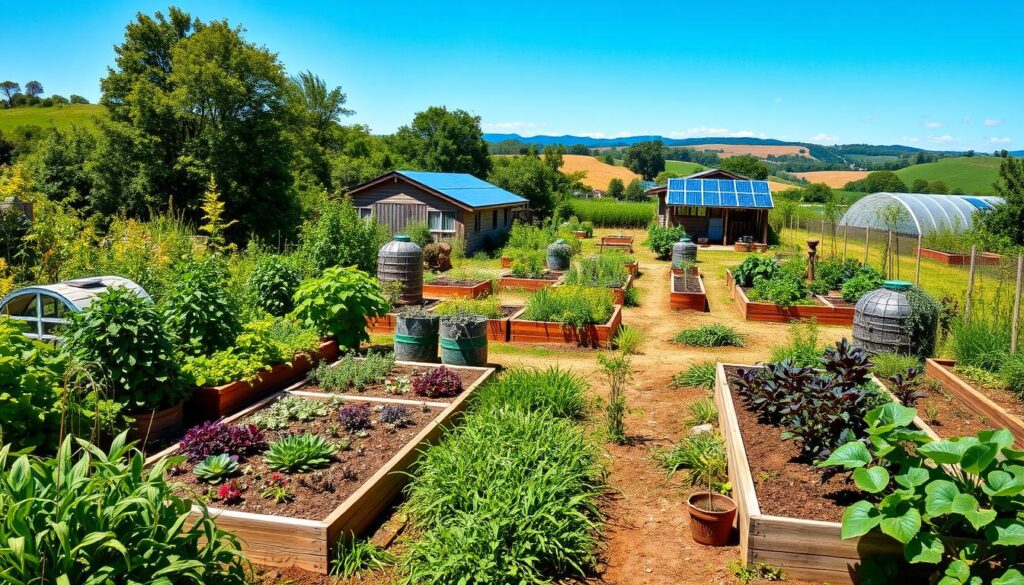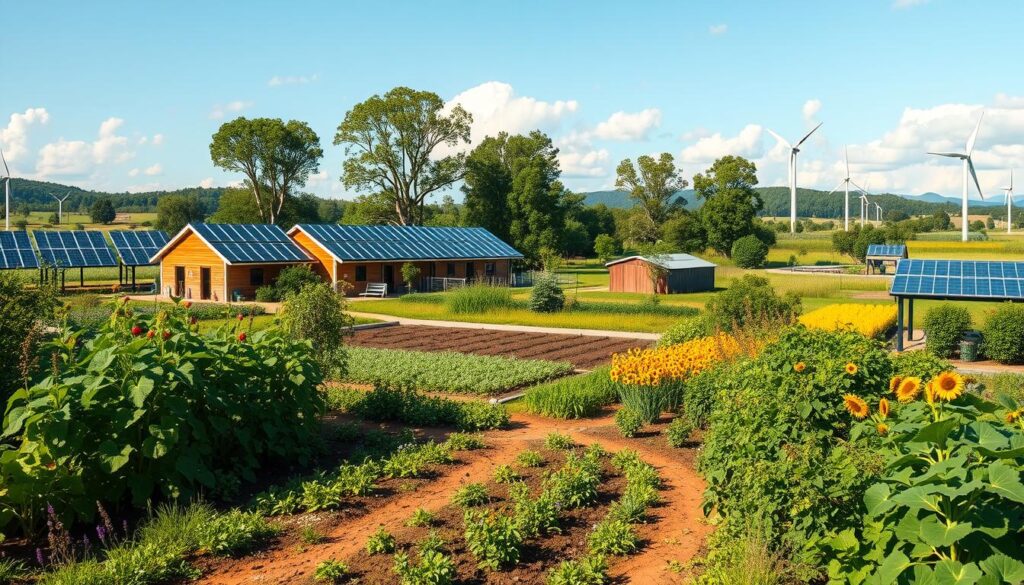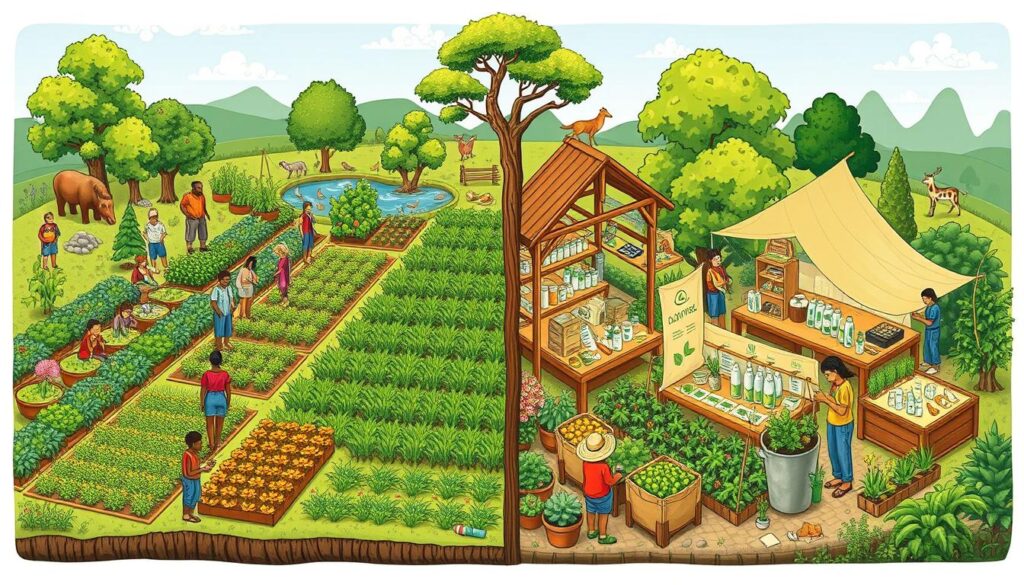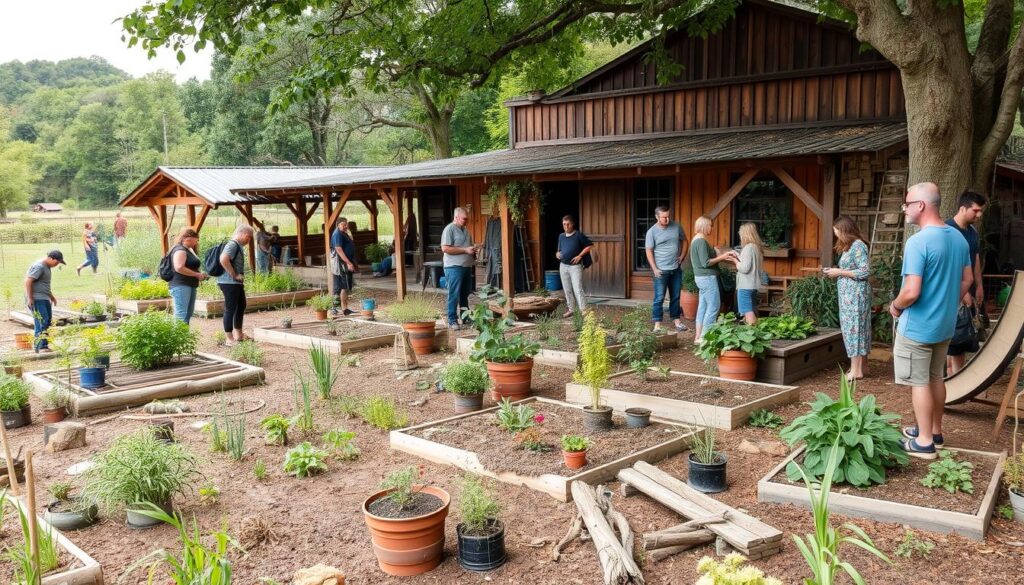What makes a permaculture business successful? How can entrepreneurs create a model that cares for people, the earth, and ensures fair share? The key is to pick the right structure for your business. This structure should focus on sustainability and regeneration.
By thinking about your goals and what you can handle, you can build a business that does well. It will also help your community and the planet.
The permaculture movement has been around since the 1970s, thanks to Bill Mollison and David Holmgren. It’s vital for business owners to grasp the concept of whole-systems thinking. This way, they can build a business that’s strong, flexible, and makes money.
Key Takeaways
- Choosing the right permaculture business structure is crucial for success
- Sustainable business practices and a regenerative business model are essential for long-term viability
- Whole-systems thinking can help entrepreneurs create a resilient and adaptable business
- Starting small and diversifying income sources can mitigate economic fluctuations
- Identifying and utilizing existing skills within the community can enhance productivity and income potential
- Permaculture principles, such as people care, earth care, and fair share, can guide business decisions and contribute to a positive impact on the environment and community
Understanding Permaculture and Its Economic Impact
Permaculture is a way to work with nature. It uses closed loop systems and renewable resources. This helps agriculture and keeps the environment healthy.
By choosing an eco-friendly business structure, companies can avoid harmful chemicals. They also promote biodiversity and work together with the community. This helps fight climate change and ensures everyone has enough food.
A good permaculture system works well on its own, like a forest. It’s important to listen to customer feedback to improve. Permaculture principles aim to use sustainable energy and manage resources wisely. By going organic, businesses can reduce their harm to the environment.
Some main benefits of permaculture are:
- Less use of harmful chemicals
- More biodiversity
- Stronger community ties
- Better food availability
- More resilient and self-sufficient communities
Introduction to Permaculture
Permaculture is a complete way to design businesses. It connects social, economic, and environmental systems. By learning permaculture, businesses can grow in a sustainable way.
This method helps create a fair and green future. Businesses can succeed without harming the planet.
Factors Influencing Business Structure Decisions
Choosing a business structure is key. It depends on the size of your operation and what you sell. Sustainable farming practices often need special tools and knowledge. A small farm might pick a sole proprietorship, while a big farm might go for an LLC to keep assets safe.
The products or services you offer also matter. Green business strategies need a structure that can change with the market. For example, a company selling eco-friendly stuff might choose a partnership or cooperative to work better together.

Important things to think about include:
* How big your operation is
* What you sell or do
* Who you’re selling to and what they want
* Who else is doing what you do
* How much money you have and where to get more
| Business Structure | Advantages | Disadvantages |
|---|---|---|
| Sole Proprietorship | Easy to start, flexible | Personal assets are at risk |
| Partnership | Shared skills and money, flexible | Liability is shared, can lead to disagreements |
| Limited Liability Company (LLC) | Keeps assets safe, flexible | Harder to set up, can cost more |
By picking the right structure, companies can use sustainable farming practices and green business strategies. This helps them grow, innovate, and make money while being kind to the planet.
Common Business Structures for Permaculture Ventures
Permaculture businesses can be set up in many ways, each with its own pros and cons. Choosing the right permaculture business structure helps a regenerative business model grow. It’s important for permaculture entrepreneurs to think about their goals, resources, and the legal side of things.
Here are some common business setups for permaculture projects:
- Sole Proprietorship: good for small, single-owner operations
- Partnerships: great for teamwork with shared ownership and decision-making
- Limited Liability Company (LLC): offers protection from liability and flexibility in ownership and management
- Corporation: gives the most protection from liability and can grow, but comes with more rules
Knowing about these business structures helps permaculture entrepreneurs make smart choices. This sets a strong base for their regenerative business model. It helps them reach their goals and contribute to a greener future.
| Business Structure | Advantages | Disadvantages |
|---|---|---|
| Sole Proprietorship | Easy to start, low costs | Full personal risk |
| Partnership | Shared ownership, combined skills | Possible disagreements, shared risk |
| LLC | Liability protection, flexible ownership | More rules, higher costs |
| Corporation | Best protection, room for growth | More rules, high costs |
Advantages and Disadvantages of Each Structure
Choosing a business structure for a permaculture venture is crucial. You need to look at tax implications, liability, and risk. By picking sustainable business practices and an eco-friendly business structure, you can reduce your environmental impact. This also helps you succeed in your business.
Operational flexibility is another important factor. Different structures offer different levels of flexibility. This affects how well you can adapt to market changes. For example, some structures work better with new technologies or strategies like renewable energy.

The right business structure depends on your venture’s goals. By weighing the pros and cons of each option, you can make a smart choice. This choice should support your vision for a sustainable future.
Legal Considerations for Permaculture Businesses
Starting a permaculture business means you must think about the legal side of things. This includes getting the right permits and following local rules. It’s important to get a license from the right authority to run your business legally.
Knowing about different licenses is key. Some licenses are clear about what you can do. Others are implied by what you do. And some licenses are personal and can’t be passed on to others.
For green business strategies, controlling invasive plants and wildlife is a must. Local laws might need you to get special permits for your work. Also, some businesses use the gift economy, which can be tricky to manage.
Some important things to think about for permaculture businesses are:
- Getting the right permits and licenses
- Following local rules
- Understanding different licenses
- Managing invasive plants and wildlife
- Using the gift economy
By focusing on organic business operations and green business strategies, permaculture businesses can grow strong and last long. This means not borrowing too much money, keeping finances balanced, and using energy wisely. Working with local communities and following rules can help your business succeed.
| License Type | Description |
|---|---|
| Express License | Clearly outlines permissions |
| Implied License | Can be inferred from actions |
| Bare License | Must be executed personally and cannot be transferred |
Choosing Between Nonprofit and For-Profit Models
Deciding between a nonprofit and for-profit model is crucial for a permaculture business. This choice affects the business’s success and longevity. Nonprofits get tax breaks, but for-profits can use nonprofit assets, creating a win-win situation.
Nonprofits might get special contracts and save on fees. But, they can’t accept donations that are tax-deductible for LLCs. This means they might miss out on some funding chances.
Important things to think about include:
- Matching the business structure with the mission and vision
- Looking into grants and crowdfunding
- Understanding the tax rules for different structures, like LLCs and C-corporations
The right choice depends on the business’s goals. By picking the best structure, permaculture businesses can focus on sustainable farming and meet their mission.

| Business Structure | Tax Implications | Funding Opportunities |
|---|---|---|
| Nonprofit | Tax-free asset acquisition | No-bid contracts, reduced fees |
| For-Profit | Varying tax implications (e.g. LLC, C-corporation) | Grants, crowdfunding, tax-deductible donations |
The Importance of a Business Plan
A good business plan is key for any permaculture project. It outlines goals, target market, and financial plans. A regenerative business model focuses on sustainability and caring for the environment. An eco-friendly structure also helps by reducing harm to the environment and attracting like-minded customers.
Some important parts of a business plan are:
- Market analysis
- Financial projections
- Marketing and sales strategies
- Management and organization
A business plan guides permaculture businesses in making smart choices. It helps in using resources well and tracking progress. By focusing on sustainability and eco-friendliness, permaculture ventures can succeed financially and help the planet.
Permaculture businesses that focus on sustainability can positively impact the environment. They also attract customers who value the same things. A solid business plan is crucial for achieving goals and making a difference for the environment.
| Business Plan Component | Importance |
|---|---|
| Market analysis | Helps identify target market and competition |
| Financial projections | Provides a roadmap for financial success |
| Marketing and sales strategies | Outlines approach to reaching customers and driving sales |
Developing a Cooperative Structure
Cooperative structures help farmers by letting them share resources and risks. They use sustainable business practices to lessen environmental harm and boost their finances. This is key in organic business operations, focusing on natural and green methods.
Cooperatives give farmers more power to negotiate, better market access, and more technical help. For instance, they can get better prices or training to improve farming. Farmers also share knowledge and resources, cutting costs and boosting efficiency.
Cooperatives are great for promoting sustainable business practices and organic business operations. They focus on the environment and social responsibility, creating value for members and the community. This builds trust with consumers who want products made responsibly and sustainably.

There are many successful cooperative models around the world. The Mondragon Cooperative Corporation in Spain is a big example, with over 80,000 employees and billions of euros in turnover. The Cooperative Group in the UK is another, running food retail and funeral services among other businesses.
| Cooperative Model | Location | Number of Members |
|---|---|---|
| Mondragon Cooperative Corporation | Spain | 80,000 |
| Cooperative Group | UK | 8 million |
Assessing Community Impact and Engagement
Assessing community impact and engagement is key in permaculture business structure. By working with local stakeholders, permaculture businesses can positively affect the environment and community. This is done through green business strategies like community-supported agriculture (CSA) models. The permaculture practice shows CSA models help consumers buy fresh, local produce and support local farmers.
Some benefits of community agriculture include:
- Increased access to fresh, healthy produce
- Support for local farmers and the local economy
- Opportunities for community engagement and education
People who garden are more likely to eat fruits and vegetables at least five times a day than those who don’t. Community agriculture also helps families save about $475 a year on groceries. By using permaculture business structure and green business strategies, businesses can positively impact the community and promote sustainability.
Overall, evaluating community impact and engagement is vital for permaculture businesses. By forming relationships with local stakeholders and using green business strategies, businesses can make a positive difference in the environment and community.
| Benefits of Community Agriculture | Description |
|---|---|
| Increased access to fresh produce | Community agriculture provides consumers with access to fresh, healthy produce |
| Support for local farmers | Community agriculture supports local farmers and the local economy |
| Community engagement and education | Community agriculture provides opportunities for community engagement and education |
Financing Your Permaculture Business
Financing a permaculture business has many options. Using sustainable farming practices can cut costs and boost efficiency. An eco-friendly business structure also draws in investors and customers who value the environment.
Grants, funding sources, and crowdfunding are some ways to get money for your permaculture business. These methods help start or grow your business. They also support sustainable farming practices and eco-friendly business structures.
Here are some key things to think about for financing a permaculture business:
- Make a strong business plan with financial details and budgeting
- Look for grants and funding that support sustainable farming practices and eco-friendly business structures
- Think about crowdfunding to get money and build a community of supporters
By looking at these options and making a detailed financing plan, permaculture businesses can succeed. They can also promote sustainable farming practices and eco-friendly business structures.
| Financing Option | Description |
|---|---|
| Grants and Funding Sources | Provide capital for permaculture businesses that promote sustainable farming practices and eco-friendly business structures |
| Crowdfunding | Allow permaculture businesses to raise capital and build a community of supporters |
Marketing Strategies for Different Business Structures
Marketing a permaculture business depends a lot on its structure. A good permaculture business structure can help it stand out. A regenerative business model, for example, focuses on being green and caring for the environment.
Branding is key in marketing a permaculture business. Effective branding makes a business unique and attracts like-minded customers. Here are some branding tips:
- Develop a unique and recognizable logo
- Use the same tone and voice everywhere
- Show your commitment to the environment
Using social media and online platforms is also smart. By sharing interesting content and talking to customers online, businesses can grow their online presence. For instance, a permaculture business could post tips on gardening or show off its products on social media.
These marketing strategies can help permaculture businesses grow online, attract new customers, and increase sales. By being green and focusing on sustainability, they can make money and help the planet at the same time.
| Marketing Strategy | Benefits |
|---|---|
| Branding | Increased recognition and customer loyalty |
| Social Media Marketing | Increased online presence and customer engagement |
| Regenerative Business Model | Contribution to a sustainable and environmentally friendly future |
Scaling Your Permaculture Business
As your permaculture business grows, it’s key to think about sustainable business practices. These practices help your business expand while being kind to the planet. You should look at market demand, resources, and your finances to decide when to grow.
Handling growth challenges needs careful planning and being flexible. Important things to consider include:
- Looking at your business’s strengths and weaknesses
- Finding new market chances and partners
- Creating a solid marketing plan
Adding sustainable business practices and green business strategies to your growth plans makes your permaculture business strong. It will help your community and the environment thrive.
Educational Resources for Permaculture Entrepreneurs
Permaculture entrepreneurs can find many educational resources to improve their skills. The Santa Cruz Permaculture Summer Institute for Educators is one such resource. It offers a five-day workshop/retreat to deepen knowledge in permaculture.
Some key aspects of permaculture education include:
- Integrating permaculture into adult and children’s education
- Developing sustainable and regenerative practices
- Building community engagement and outreach
These resources help entrepreneurs build a strong permaculture business structure. They also help in implementing effective organic business operations. This leads to a more sustainable and resilient future.
By using these educational resources, entrepreneurs can gain the knowledge needed to succeed. They can make a positive impact on their communities.
| Resource | Description |
|---|---|
| Santa Cruz Permaculture Summer Institute for Educators | A five-day workshop/retreat focused on permaculture education and community engagement |
| Online learning platforms | Various online courses and resources focused on permaculture and sustainable business practices |
Networking Opportunities in the Permaculture Community
Permaculture entrepreneurs can find great benefits in the community. They can learn sustainable farming practices and build an eco-friendly business structure. Joining associations and attending events helps them meet others and share knowledge.
Groups like the Permaculture Research Institute and the European Permaculture Convergence are key. They offer a space for permaculturists to exchange ideas and grow together. This helps the permaculture movement expand and thrive.
Workshops and training programs are also valuable. They teach the skills needed for a sustainable business. Topics include permaculture design, organic farming, and eco-friendly business management.
| Association | Event | Description |
|---|---|---|
| Permaculture Research Institute | Annual Conference | A gathering of permaculturists to share knowledge and experiences |
| European Permaculture Convergence | Biennial Conference | A platform for permaculturists to connect and learn from each other |
By using these networking chances, permaculture entrepreneurs can build a strong network. They gain access to important resources and knowledge. This helps them grow their business while supporting the permaculture community.
Evaluating Success and Impact
When looking at permaculture business structure, it’s key to measure success and impact. A regenerative business model focuses on more than just making money. It aims to plant trees, grow food forests, and help projects in third-world countries. To gauge success, consider these metrics:
Permaculture businesses meet community needs and help people grow. They offer jobs that are fair and support workers’ growth. It’s important for these businesses to be financially stable and free from debt. This aligns with permaculture’s values of freedom and sustainability.
- Start small and grow in stages to ensure stability and growth.
- Every project goes through four stages: birth, development, decline, and death. This shows the need to adapt to the market.
- “Diversity builds resilience” in permaculture. This means using different strategies to achieve goals.
By using a permaculture business structure and model, companies can make a positive impact. They can reduce harm to the environment and help communities grow. As permaculture design principles focus on sustainability, businesses can use resources wisely and adopt a holistic approach.
Future Trends in Permaculture Business Structures
The permaculture movement is growing, bringing new ideas and tech to the table. We’ll see more focus on being green and adaptable. This is as permaculture businesses aim to be eco-friendly and self-sufficient.
Innovations and Technologies
New tech in renewable energy and smart farming will change how permaculture businesses work. Things like automated irrigation and AI for crop monitoring will make things more efficient. Blockchain could also change how we track products, making things more transparent.
Sustainability and Resilience Strategies
Permaculture businesses will focus more on being sustainable and resilient. They’ll use circular economy ideas and regenerative farming. This way, they can reduce waste and be more efficient, helping them thrive in a changing world.

